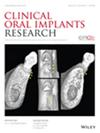Vertical Ridge Augmentation in the Anterior Maxilla Using a Dual‐Texture e‐PTFE Membrane and Autogenous Bone: A 2‐ to 5‐Year Retrospective Case‐Series Study
IF 5.3
1区 医学
Q1 DENTISTRY, ORAL SURGERY & MEDICINE
引用次数: 0
Abstract
ObjectivesTo evaluate a novel protocol for vertical ridge augmentation with titanium‐(Ti)‐reinforced dual‐texture expanded polytetrafluoroethylene (e‐PTFE) membranes, 100% autogenous bone, and 12 months of bone healing in the anterior maxilla.Material and MethodsThis retrospective study included 14 consecutive patients treated between 2016 and 2021. Large defects, including both vertical and horizontal components, were treated with autogenous bone grafting and non‐resorbable Ti‐reinforced dual‐texture e‐PTFE membranes. Implants were placed in the augmented bone after 12 months. All clinical and radiographical parameters were retrieved from patient records.ResultsThe case series included 14 patients treated with 15 e‐PTFE membranes. The mean initial vertical defect size was 7.5 ± 5.1 mm (range: 3–23 mm). All membranes remained unexposed during the entire healing period (12.6 ± 1.2 months). No complications that needed intervention occurred. Complete bone fill was achieved, that is, regenerated bone filled the entire volume created by the membrane, in all treated defects. Twenty‐three implants were placed. The survival rate was 100% and the mean marginal bone level was 0.08 ± 0.11 mm after up to 5 years.ConclusionsExcellent vertical augmentation outcomes can be achieved in the anterior maxilla using a non‐resorbable Ti‐reinforced e‐PTFE membrane and an autogenous bone graft, followed by 12 months of healing before implant placement. The implants demonstrated stable marginal bone levels after loading. This case series has limitations, mainly the retrospective nature and small sample size, but it indicates that the proper choice of methods, materials, and healing times during GBR results in a predictable clinical outcome.使用双纹理e - PTFE膜和自体骨在前上颌垂直嵴增强:一项2 - 5年回顾性病例系列研究
目的:评价一种采用钛(Ti)增强双纹理膨胀聚四氟乙烯(e - PTFE)膜、100%自体骨和上颌前牙12个月骨愈合的垂直嵴增强新方案。材料和方法本回顾性研究纳入了2016年至2021年间连续治疗的14例患者。大的缺陷,包括垂直和水平的组件,用自体植骨和不可吸收的钛增强双纹理e - PTFE膜进行治疗。12个月后将植入物放置在增强骨中。从患者记录中检索所有临床和影像学参数。结果14例患者接受了15个e - PTFE膜治疗。平均初始垂直缺陷尺寸为7.5±5.1 mm(范围:3-23 mm)。所有膜在整个愈合期间(12.6±1.2个月)均未暴露。未发生需要干预的并发症。在所有处理过的缺损中,实现了完全的骨填充,即再生骨填充了由膜产生的整个体积。共植入了23个植入物。术后5年生存率为100%,平均骨缘水平为0.08±0.11 mm。结论采用不可吸收性钛增强膜和自体骨移植可获得良好的上颌骨垂直增强效果,种植体植入术前愈合12个月。植入物在加载后表现出稳定的边缘骨水平。该病例系列具有局限性,主要是回顾性和小样本量,但它表明,在GBR中正确选择方法、材料和愈合时间可导致可预测的临床结果。
本文章由计算机程序翻译,如有差异,请以英文原文为准。
求助全文
约1分钟内获得全文
求助全文
来源期刊

Clinical Oral Implants Research
医学-工程:生物医学
CiteScore
7.70
自引率
11.60%
发文量
149
审稿时长
3 months
期刊介绍:
Clinical Oral Implants Research conveys scientific progress in the field of implant dentistry and its related areas to clinicians, teachers and researchers concerned with the application of this information for the benefit of patients in need of oral implants. The journal addresses itself to clinicians, general practitioners, periodontists, oral and maxillofacial surgeons and prosthodontists, as well as to teachers, academicians and scholars involved in the education of professionals and in the scientific promotion of the field of implant dentistry.
 求助内容:
求助内容: 应助结果提醒方式:
应助结果提醒方式:


